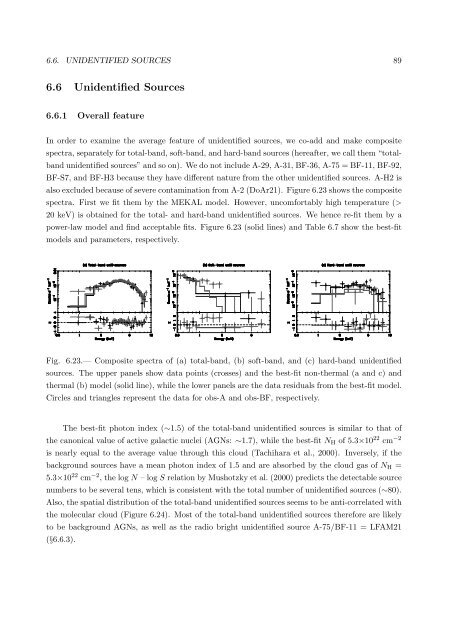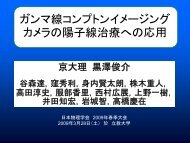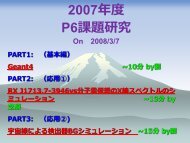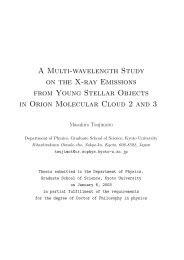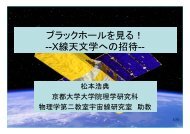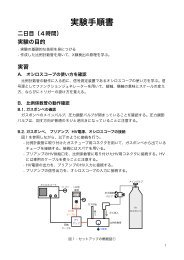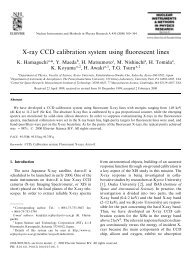X-ray Study of Low-mass Young Stellar Objects in the ρ Ophiuchi ...
X-ray Study of Low-mass Young Stellar Objects in the ρ Ophiuchi ...
X-ray Study of Low-mass Young Stellar Objects in the ρ Ophiuchi ...
Create successful ePaper yourself
Turn your PDF publications into a flip-book with our unique Google optimized e-Paper software.
6.6. UNIDENTIFIED SOURCES 896.6 Unidentified Sources6.6.1 Overall featureIn order to exam<strong>in</strong>e <strong>the</strong> average feature <strong>of</strong> unidentified sources, we co-add and make compositespectra, separately for total-band, s<strong>of</strong>t-band, and hard-band sources (hereafter, we call <strong>the</strong>m “totalbandunidentified sources” and so on). We do not <strong>in</strong>clude A-29, A-31, BF-36, A-75 = BF-11, BF-92,BF-S7, and BF-H3 because <strong>the</strong>y have different nature from <strong>the</strong> o<strong>the</strong>r unidentified sources. A-H2 isalso excluded because <strong>of</strong> severe contam<strong>in</strong>ation from A-2 (DoAr21). Figure 6.23 shows <strong>the</strong> compositespectra. First we fit <strong>the</strong>m by <strong>the</strong> MEKAL model. However, uncomfortably high temperature (>20 keV) is obta<strong>in</strong>ed for <strong>the</strong> total- and hard-band unidentified sources. We hence re-fit <strong>the</strong>m by apower-law model and f<strong>in</strong>d acceptable fits. Figure 6.23 (solid l<strong>in</strong>es) and Table 6.7 show <strong>the</strong> best-fitmodels and parameters, respectively.Fig. 6.23.— Composite spectra <strong>of</strong> (a) total-band, (b) s<strong>of</strong>t-band, and (c) hard-band unidentifiedsources. The upper panels show data po<strong>in</strong>ts (crosses) and <strong>the</strong> best-fit non-<strong>the</strong>rmal (a and c) and<strong>the</strong>rmal (b) model (solid l<strong>in</strong>e), while <strong>the</strong> lower panels are <strong>the</strong> data residuals from <strong>the</strong> best-fit model.Circles and triangles represent <strong>the</strong> data for obs-A and obs-BF, respectively.The best-fit photon <strong>in</strong>dex (∼1.5) <strong>of</strong> <strong>the</strong> total-band unidentified sources is similar to that <strong>of</strong><strong>the</strong> canonical value <strong>of</strong> active galactic nuclei (AGNs: ∼1.7), while <strong>the</strong> best-fit N H <strong>of</strong> 5.3×10 22 cm −2is nearly equal to <strong>the</strong> average value through this cloud (Tachihara et al., 2000). Inversely, if <strong>the</strong>background sources have a mean photon <strong>in</strong>dex <strong>of</strong> 1.5 and are absorbed by <strong>the</strong> cloud gas <strong>of</strong> N H =5.3×10 22 cm −2 , <strong>the</strong> log N – log S relation by Mushotzky et al. (2000) predicts <strong>the</strong> detectable sourcenumbers to be several tens, which is consistent with <strong>the</strong> total number <strong>of</strong> unidentified sources (∼80).Also, <strong>the</strong> spatial distribution <strong>of</strong> <strong>the</strong> total-band unidentified sources seems to be anti-correlated with<strong>the</strong> molecular cloud (Figure 6.24). Most <strong>of</strong> <strong>the</strong> total-band unidentified sources <strong>the</strong>refore are likelyto be background AGNs, as well as <strong>the</strong> radio bright unidentified source A-75/BF-11 = LFAM21(§6.6.3).


